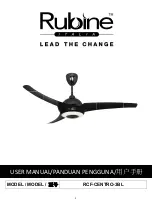
17
Fan Unit ELS-V..
Installation and Operating Instructions
8.2 Servicing and maintenance
m
The safety instructions specified in section 1.2 must be observed!
The fan must be fully isolated from the power supply before all work and before opening the terminal compart-
ment!
– There is no provision for maintenance beyond the scope of user maintenance. If maintenance work is still
required (due to faults), then this must be carried out by electricians!
– Excessive deposits of dirt, dust, grease, etc. on the impeller, motor, protection guard and, above all, between the
casing and the impeller, are not permitted, as these can lead to an unbalance in the impeller, overheating of the
motor or the blocking of the impeller. In such cases, the unit must be cleaned.
– In cases of longer periods of standstill, maintenance must be carried out when the unit is restarted.
The following should be checked:
• Secure mounting of the fan in casing, replace in case of doubt.
• Remove dirt deposits.
• In case of mechanical damage, replace damaged parts or decommission the unit (the fan unit can only be replaced
as a whole).
• Check tightness of screw connections, do not loosen screws in the process!
• Casing quality (cracks, brittleness of the plastic)
• Free movement of the impeller. If the impeller does not move freely, see Fault causes in section 8.3!
• Bearing noises
• Vibrations – see Fault causes in section 8.3
• Check power consumption according to type plate – see Fault causes in section 8.3
8.3 Fault causes
m
The safety instructions specified in section 1.2 must be observed!
– General fault causes
See section 7 for function-specific faults.
8.3 Standstill and disposal
m
The safety instructions specified in section 1.2 must be observed!
The instructions in section 1.5 must be observed for shipping.
Parts and components of the fan, whose service life has expired, e.g. due to wear and tear, corrosion, mechanical load,
fatigue and/or other effects that cannot be directly discerned, must be disposed of expertly and properly after disas-
sembly in accordance with the national and international laws and regulations.
The same also applies to auxiliary materials in use. Such as oils and greases or other substances. The intended and
unintended further use of worn parts, e.g. impellers, rolling bearings, filters, etc. can result in danger to persons, the
environment as well as machines and systems. The corresponding operator guidelines applicable on-site must be
observed and used.
m
DANGER
m
DANGER
Fault
Cause
Solution
Fan does not start
– No voltage
Check mains voltage
Check connection according to wiring diagram
– Impeller blocked
Clear blockage (facade screws too long), clean,
replace fan unit if necessary
– Motor blocked
Replace fan unit
Fuse has tripped
– Shorted coil in motor
Replace fan unit
– Supply line/connection damaged or
defective control board.
Replace parts, replace fan unit if necessary
(contact Helios customer service team)
– Connected incorrectly
Check, modify connection
Vibrations
– Contamination
Clean
– Attachment-related resonance
Check or repair attachment
Abnormal noises
– Grinding impeller
Clean impeller, replace fan unit if necessary
– Bearing damage
Replace fan unit
– Mechanical damage
Carry out maintenance
Fan no longer perfor-
ming (speed)
– Filter contaminated/clogged
Check/clean/replace filter
– Insufficient air delivery
Check/clear inflow and outflow
– Incorrect voltage
Check/modify connection
– Bearing damage
Replace fan unit
– Contamination
Clean
– Insufficient backflow
Widen backflow openings
EN






































